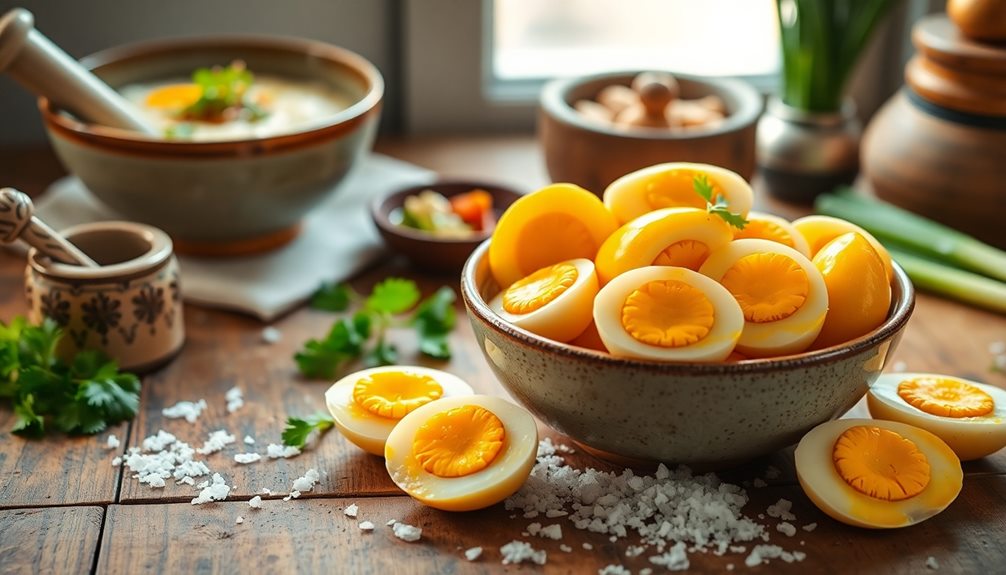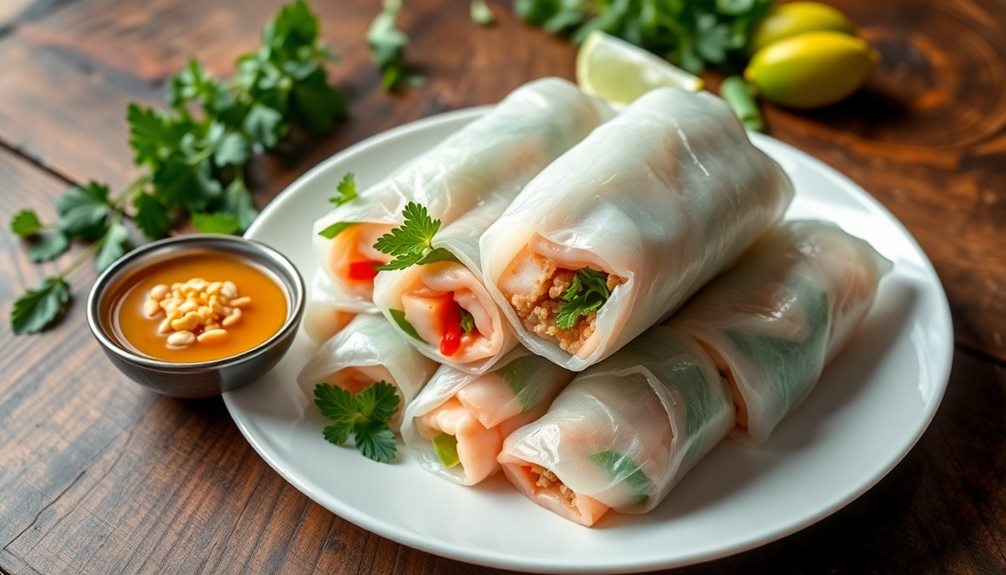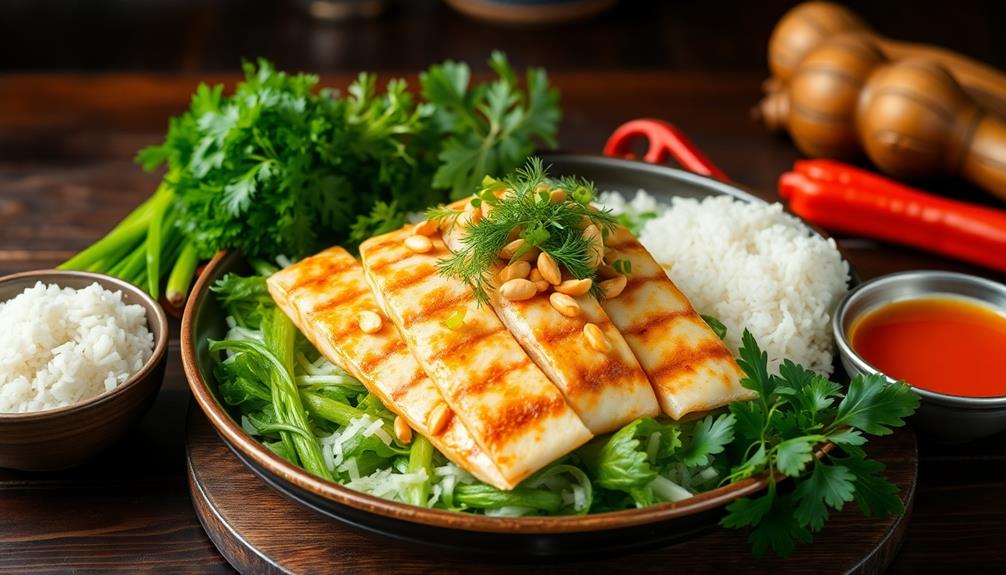Bánh tét is a tasty Vietnamese tamale filled with pork and mung beans. This delicious dish is made from glutinous rice, wrapped in banana leaves, and steamed to perfection. It's traditionally enjoyed during the Lunar New Year as a symbol of good fortune and family unity. First, you soak the sticky rice and mung beans overnight, then mix, wrap, and steam them for several hours. The result is a warm, comforting treat you can share with loved ones. Making bánh tét is a special way to connect with tradition and family, and you'll discover even more exciting details soon!
Key Takeaways
- Bánh Tét is a traditional Vietnamese tamale made with glutinous rice, pork, and mung beans, wrapped in banana leaves.
- The dish symbolizes good fortune, unity, and love, especially during Lunar New Year celebrations.
- Preparation involves soaking rice and mung beans, cooking them, and then wrapping the mixture in banana leaves before steaming.
- Bánh Tét is traditionally shared during family meals and celebrations, emphasizing community and cultural heritage.
- Modern variations include different fillings and vegan options, maintaining its traditional roots while evolving in contemporary cuisine.
History
Bánh tét, a traditional Vietnamese tamale, has roots that stretch back centuries, intertwining with the country's agricultural practices and cultural heritage.
You might find it fascinating that bánh tét is often made during the Lunar New Year, a time when families come together to celebrate and remember their ancestors. It's not just a tasty treat; it symbolizes good fortune and unity!
The dish originally comes from the southern regions of Vietnam, where sticky rice grows abundantly. People would wrap the rice around fillings like mung beans and pork, then package them in banana leaves.
This clever way of cooking helped preserve the food, especially during long journeys or festivals.
As you enjoy bánh tét, you're tasting a piece of history! Each bite connects you to the farmers who cultivated the rice and the families who passed down the recipe through generations.
It's more than just food; it's a story of love, tradition, and community. So next time you savor this delicious tamale, remember the rich history that makes it so special.
Bánh tét brings people together, just like the celebrations that honor its heritage!
Cooking Steps
How do you begin crafting the delicious b́ánh tét? First, gather your ingredients: glutinous rice, mung beans, pork, banana leaves, and some salt.
Start by soaking the glutinous rice and mung beans in water overnight. This makes them soft and ready for cooking. Engaging in sensory experiences while cooking can enhance your cognitive skills and promote baby enrichment toys for your little ones.
Next, cook the mung beans until they're tender, then mash them up. While that's cooling, prepare your pork by seasoning it with salt and some pepper.
Now, it's time to wrap everything! Take a banana leaf, cut it into rectangles, and lay one piece down. Spread a layer of rice, then add a layer of mashed mung beans, followed by your seasoned pork. Finally, cover it with more rice.
Now, fold the banana leaf tightly around your filling, making sure it's secure. You can tie it with kitchen twine for extra support.
Place your wrapped b́ánh tét in a large pot of boiling water and let them cook for about six hours. Yes, six hours! But don't worry, they'll smell amazing.
Once they're done, unwrap them, slice them up, and enjoy this tasty treat with family and friends!
Step 1. Prepare Sticky Rice Mixture
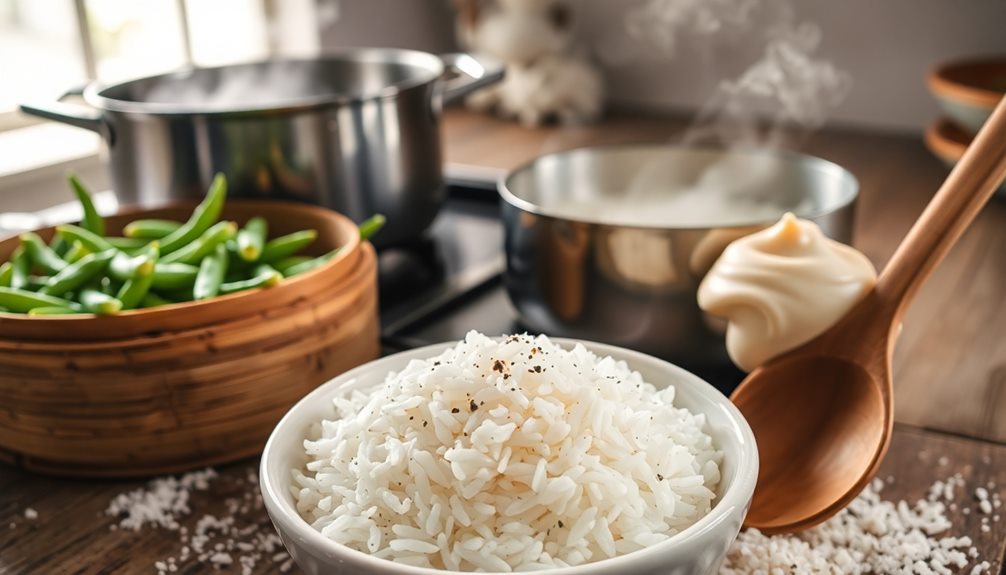
To prepare the sticky rice mixture for your bánh tét, start by rinsing about four cups of glutinous rice under cold water until the water runs clear. This helps to remove any excess starch, making your rice nice and sticky!
Once you've rinsed the rice, soak it in water for at least four hours or overnight if you can. Soaking is important because it helps the rice cook evenly and achieve that perfect chewy texture.
After soaking, drain the rice and place it in a large bowl. Now, it's time to season! Add about a teaspoon of salt and gently mix it in. This little bit of salt enhances the flavor of the rice, making it delicious.
Next, you'll want to use a steamer. Line it with a clean cloth to prevent the rice from falling through. Spread the rice evenly in the steamer, then cover it with the cloth.
Steam the rice for about 30 to 40 minutes, or until it's tender and slightly translucent. Don't forget to check it occasionally to make sure it's cooking evenly! Once it's done, let it cool a bit before you move on to the next step. Enjoy the aroma!
Step 2. Add Mung Beans Mixture

Now that your sticky rice is ready, it's time to focus on the mung beans mixture. First, grab those soaked mung beans you prepared earlier. Drain them and place them in a pot with just enough water to cover them. Bring the water to a gentle boil, then reduce the heat and let them simmer for about 15 minutes, or until they're nice and soft.
Once the beans are cooked, drain any excess water. Now, you can mash them up! Use a fork or a potato masher to create a smooth paste. If you like a little sweetness, mix in some sugar to taste. Don't forget to add a pinch of salt to enhance the flavor.
Next, if you're using pork, you can mix it in with the mung beans for extra deliciousness! Stir everything together until it's well combined. This mixture is going to be the heart of your bánh tét, giving it that rich and creamy texture.
Now, you're ready to move on to the next exciting step in making your Vietnamese tamale. You're doing great, and soon, you'll have a tasty treat to share!
Step 3. Wrap in Banana Leaves
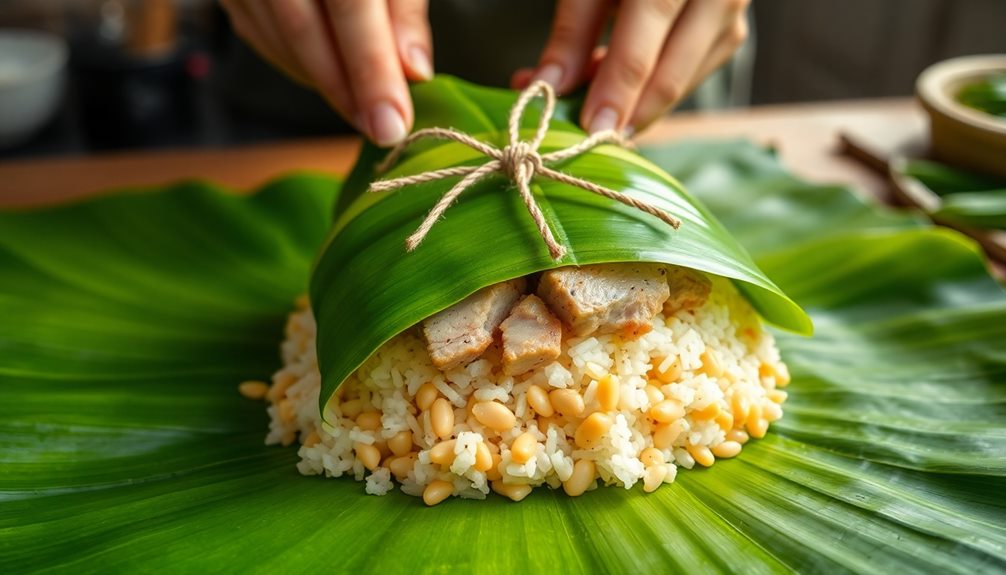
Wrapping your bành tét in banana leaves adds not only flavor but also a beautiful presentation.
First, lay out a large piece of banana leaf on a clean surface. Make sure the shiny side is facing down. Then, place a portion of your rice mixture in the center of the leaf. You want enough to form a nice shape, so don't be shy!
Next, add your savory pork and mung beans right on top of the rice. Now it's time to fold the banana leaf! Start by folding the sides over the filling, creating a neat package.
Then, fold the top and bottom edges in, making sure everything is snug and secure. Once you've got a tight wrap, use kitchen twine or string to tie it all together.
You can make a couple of loops to keep it from falling apart. Don't worry if it looks a bit messy; it's all part of the fun! Your bành tét is now ready for steaming!
The banana leaves not only keep everything together but also infuse the tamale with a lovely aroma during cooking. Enjoy the process; your delicious treat is almost here!
Step 4. Steam for Two Hours
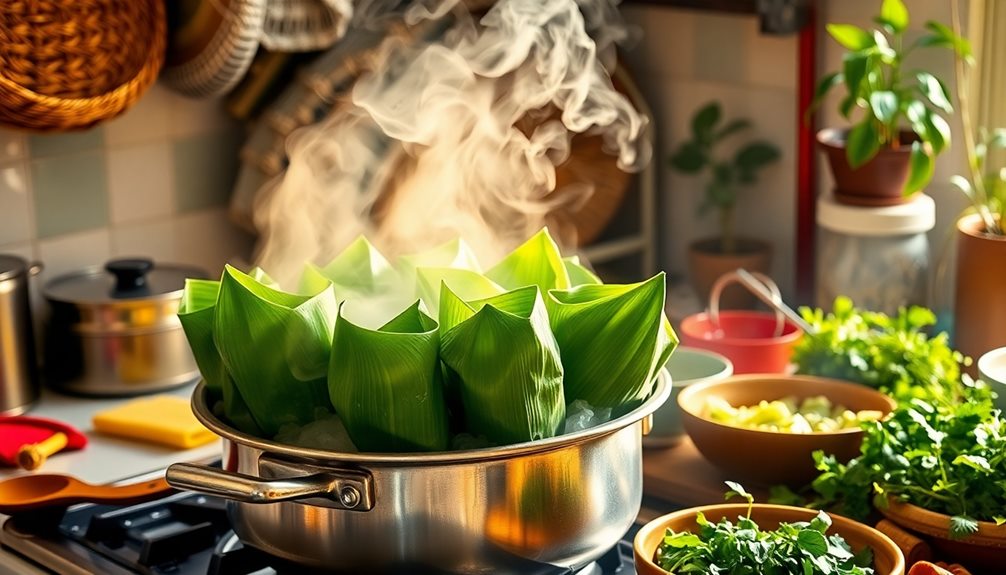
Steaming your bành tét for two hours is crucial to ensure it cooks thoroughly and develops its rich flavors.
Once you have your wrapped bành tét ready, place them in a steamer. Make sure the steamer has plenty of water to keep the steam going strong. You don't want it to run dry!
While the bành tét is steaming, the delicious aromas will start to fill your kitchen, making everyone curious. Keep an eye on the water level, and if it gets too low, just add more hot water to keep the steam flowing.
After about two hours, you'll want to check if the bành tét is done. A good way to tell is if you can easily insert a skewer or knife through the center, and it comes out clean. If it's still a bit sticky, give it another few minutes.
Once it's done, be ready to enjoy the amazing flavors of your hard work!
Steaming is an essential step to ensure you have the perfect bành tét, so don't rush it. You're almost there, and the tasty treat will be worth the wait!
Step 5. Cool Before Slicing
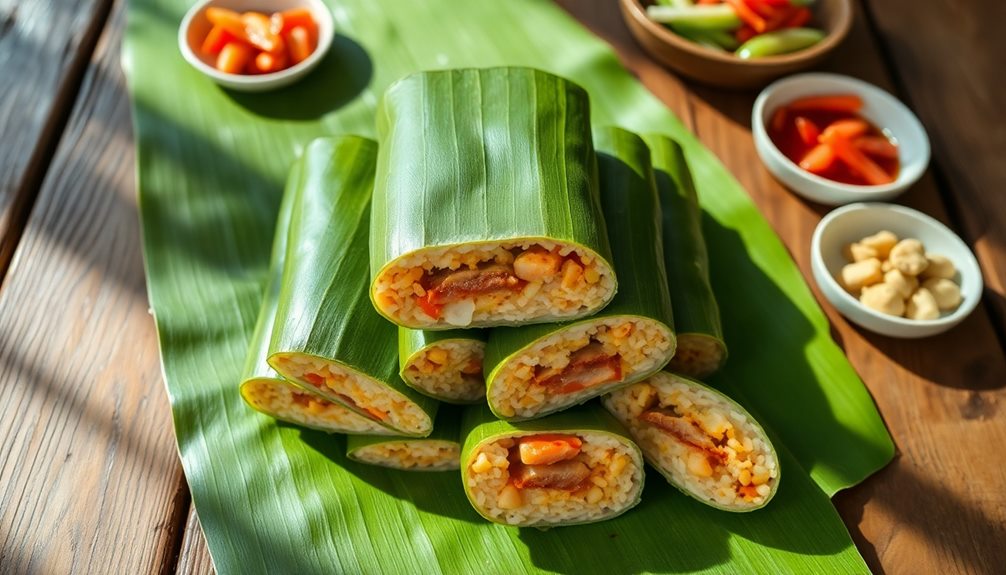
After steaming, you'll need to let the bánh tét cool before slicing it. This step is super important because it helps the flavors blend and makes cutting easier.
First, take the bánh tét out of the steamer and place it on a cooling rack or a plate. Let it sit for at least an hour. This way, the rice will firm up, and you won't squish it when you slice.
While it's cooling, you might notice the delicious aroma filling your kitchen. Isn't that exciting? You can even start imagining how tasty it'll be!
After the hour, gather a sharp knife and some warm water. Dipping your knife in warm water helps prevent the rice from sticking.
Now, you're ready to slice! Cut it into thick pieces, about an inch wide. Each slice reveals the lovely layers of pork and mung beans. Isn't it pretty?
Once you're done, you can serve it warm or at room temperature. Enjoy your bánh tét with family and friends, and don't forget to share how you made it! They'll love hearing your cooking adventure.
Final Thoughts
When you explore the world of Vietnamese tamales, or Bánh Tét, you discover a dish steeped in culture and tradition. This tasty treat is more than just food; it's a symbol of family gatherings and celebrations.
Imagine the excitement of making Bánh Tét with your loved ones, wrapping it up in banana leaves, and sharing stories while you work.
Bánh Tét is filled with delicious ingredients like savory pork and smooth mung beans, making each bite a delightful experience. When you slice into it, you'll see the beautiful layers, and you might even feel a sense of pride knowing you've created something special.
Don't forget, enjoying Bánh Tét is about sharing it with others. Whether it's at a big family meal or a small get-together with friends, this dish brings people together.
So, as you take that first bite, think about the love and tradition behind it. You're not just tasting a dish; you're part of a story that's been told for generations.
Frequently Asked Questions
Can Bánh Tét Be Frozen for Later Consumption?
Yes, you can freeze bánh tét for later consumption. Just wrap them tightly in plastic wrap or foil, then place them in an airtight container. When you're ready, thaw and reheat for delicious results.
What Are Common Variations of Bánh Tét?
You'll find various bành tét variations, including those filled with mung beans, pork, or even vegetarian options. Some might have different flavors, like coconut or banana, offering a delightful twist on this traditional dish.
Where Can I Buy Bánh Tét in the US?
You can buy bành tét at Asian grocery stores, local Vietnamese restaurants, or online through specialty food websites. Don't forget to check farmers' markets during festive seasons, as vendors often sell homemade versions.
Is Bánh Tét Gluten-Free?
Bánh tét typically contains glutinous rice, which is gluten-free. However, always check the specific ingredients, as some variations might include additives or sauces that contain gluten. It's best to confirm with the seller before enjoying it.
How Do I Reheat Leftover Bánh Tét?
To reheat leftover bánh tét, wrap it in a damp paper towel and microwave for about 1-2 minutes. Alternatively, steam it for 10-15 minutes until heated through. Enjoy your delicious treat again!




